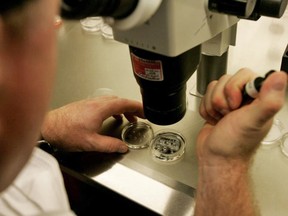Science
Scientists Create Fertilizable Eggs from Human Skin Cells

Scientists have successfully transformed human skin cells into fertilizable eggs, marking a significant breakthrough in reproductive technology. This achievement, announced on March 15, 2024, could potentially provide new options for individuals facing infertility, which affects approximately one in six people worldwide. The research team, based in the United States, cautioned that while the study holds promise, it remains years away from practical application for aspiring parents.
Paula Amato, a researcher at the Oregon Health & Science University and co-author of the study, explained that this technology, known as in-vitro gametogenesis (IVG), could enable older women or those who lack viable eggs for various reasons to have children. “It also would allow same-sex couples to have a child genetically related to both partners,” she added.
Breakthrough Technique and Research Findings
The study, published in the journal Nature Communications, builds on previous advancements in reproductive science. Notably, Japanese researchers had earlier announced the creation of mice with two biological fathers in July 2023. However, this new research is particularly groundbreaking because it utilizes DNA from human cells rather than animal models.
The process began with scientists removing the nucleus from skin cells and transferring it into a donor egg cell that had its nucleus removed, a technique known as somatic cell nuclear transfer. This method was previously used in cloning the famous sheep, Dolly, in 1996. A key challenge was to reduce the 46 chromosomes present in skin cells to the 23 chromosomes typical of eggs. The researchers developed a strategy termed “mitomeiosis” to mimic the natural cell division process, enabling them to create 82 developing eggs, or oocytes.
These oocytes were then fertilized using in vitro fertilization (IVF) techniques. After six days, approximately nine percent of the embryos reached the blastocyst stage, the point at which they could theoretically be transferred to a uterus. Despite this achievement, the researchers noted that the embryos exhibited various abnormalities, prompting the conclusion of the experiment at that stage.
While the nine percent success rate is modest, Amato highlighted that natural reproduction typically sees only about one-third of embryos progress to the IVF-ready blastocyst stage. She estimates that it may take at least a decade for this technology to become widely available for clinical use. “The biggest hurdle is trying to achieve genetically normal eggs with the correct number and complement of chromosomes,” she stated.
Implications for Future Reproductive Options
The implications of this research extend beyond traditional fertility treatments. Ying Cheong, a reproductive medicine researcher at the University of Southampton, described the findings as “exciting.” She remarked, “For the first time, scientists have shown that DNA from ordinary body cells can be placed into an egg, activated, and made to halve its chromosomes, mimicking the special steps that normally create eggs and sperm.”
This development could alter the landscape of infertility and miscarriage, potentially leading to the creation of egg or sperm-like cells for individuals with limited options. Other researchers are exploring different methods to create eggs in laboratory settings, such as reprogramming skin cells into induced pluripotent stem cells, which have the capability to develop into any cell type.
Amato acknowledged that it remains unclear which technique will prove more successful in the long run, emphasizing that both approaches necessitate further research and development before they can be deemed viable.
The research adhered to established ethical guidelines concerning embryo use in the United States, ensuring that the study was conducted responsibly while pushing the boundaries of reproductive science. As this promising area of research continues to evolve, it may one day offer hope to countless individuals seeking to build their families.
-

 Lifestyle1 month ago
Lifestyle1 month agoWinnipeg Celebrates Culinary Creativity During Le Burger Week 2025
-

 Health2 months ago
Health2 months agoMontreal’s Groupe Marcelle Leads Canadian Cosmetic Industry Growth
-

 Science2 months ago
Science2 months agoMicrosoft Confirms U.S. Law Overrules Canadian Data Sovereignty
-

 Education2 months ago
Education2 months agoRed River College Launches New Programs to Address Industry Needs
-

 Technology2 months ago
Technology2 months agoDragon Ball: Sparking! Zero Launching on Switch and Switch 2 This November
-

 Science2 months ago
Science2 months agoTech Innovator Amandipp Singh Transforms Hiring for Disabled
-

 Technology2 months ago
Technology2 months agoGoogle Pixel 10 Pro Fold Specs Unveiled Ahead of Launch
-

 Science2 months ago
Science2 months agoChina’s Wukong Spacesuit Sets New Standard for AI in Space
-

 Technology2 months ago
Technology2 months agoWorld of Warcraft Players Buzz Over 19-Quest Bee Challenge
-

 Science2 months ago
Science2 months agoXi Labs Innovates with New AI Operating System Set for 2025 Launch
-

 Business2 months ago
Business2 months agoDawson City Residents Rally Around Buy Canadian Movement
-

 Business2 months ago
Business2 months agoNew Estimates Reveal ChatGPT-5 Energy Use Could Soar
-

 Technology2 months ago
Technology2 months agoInnovative 140W GaN Travel Adapter Combines Power and Convenience
-

 Technology2 months ago
Technology2 months agoFuture Entertainment Launches DDoD with Gameplay Trailer Showcase
-

 Technology2 months ago
Technology2 months agoGlobal Launch of Ragnarok M: Classic Set for September 3, 2025
-

 Education2 months ago
Education2 months agoAlberta Teachers’ Strike: Potential Impacts on Students and Families
-

 Technology2 months ago
Technology2 months agoNew IDR01 Smart Ring Offers Advanced Sports Tracking for $169
-

 Technology2 months ago
Technology2 months agoArsanesia Unveils Smith’s Chronicles with Steam Page and Trailer
-

 Technology2 months ago
Technology2 months agoHumanoid Robots Compete in Hilarious Debut Games in Beijing
-

 Science2 months ago
Science2 months agoNew Precision Approach to Treating Depression Tailors Care to Patients
-

 Health2 months ago
Health2 months agoGiant Boba and Unique Treats Take Center Stage at Ottawa’s Newest Bubble Tea Shop
-

 Technology2 months ago
Technology2 months agoQuoted Tech Launches Back-to-School Discounts on PCs
-

 Business2 months ago
Business2 months agoBNA Brewing to Open New Bowling Alley in Downtown Penticton
-

 Technology2 months ago
Technology2 months agoDiscover the Relaxing Charm of Tiny Bookshop: A Cozy Gaming Escape










